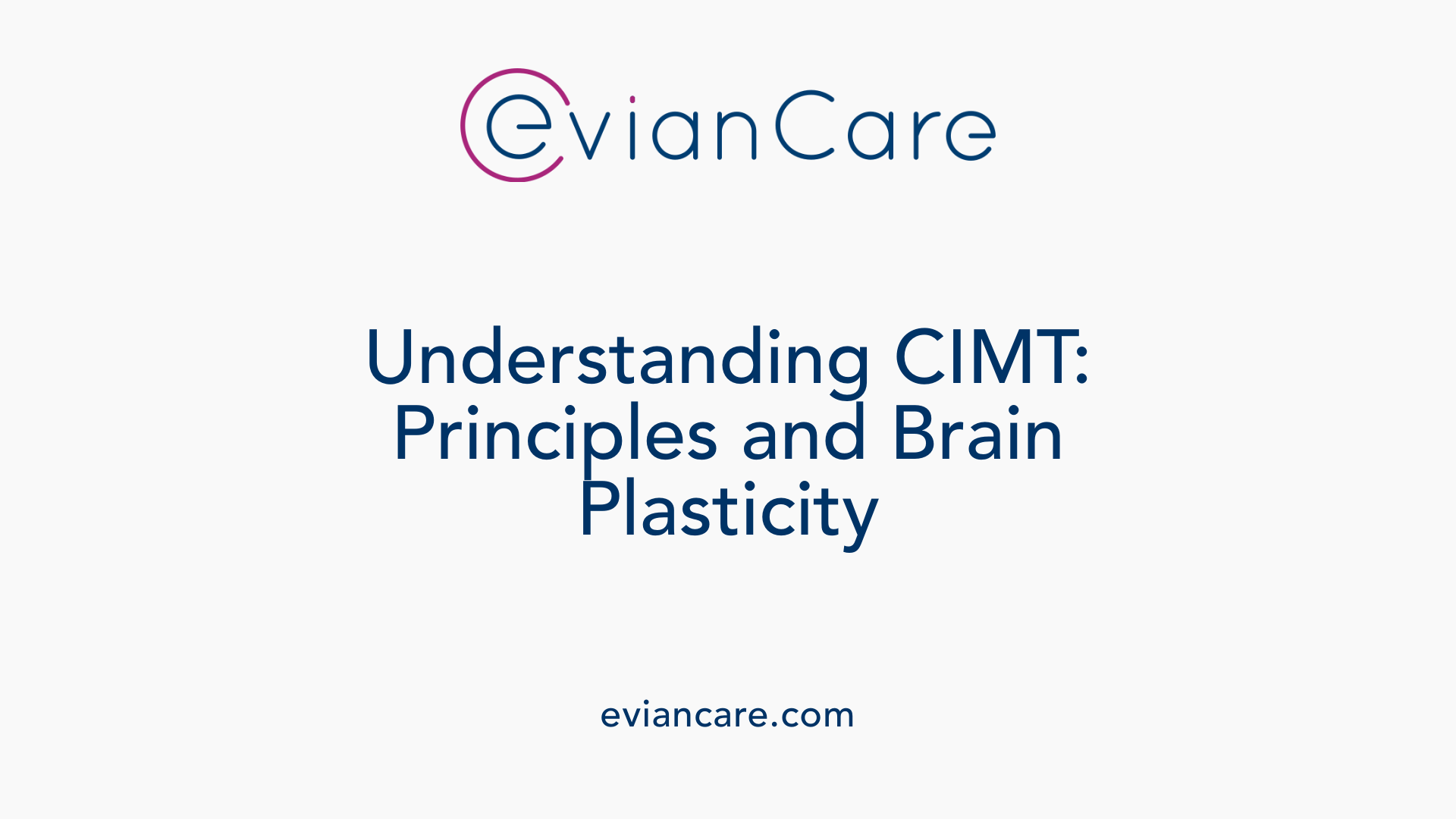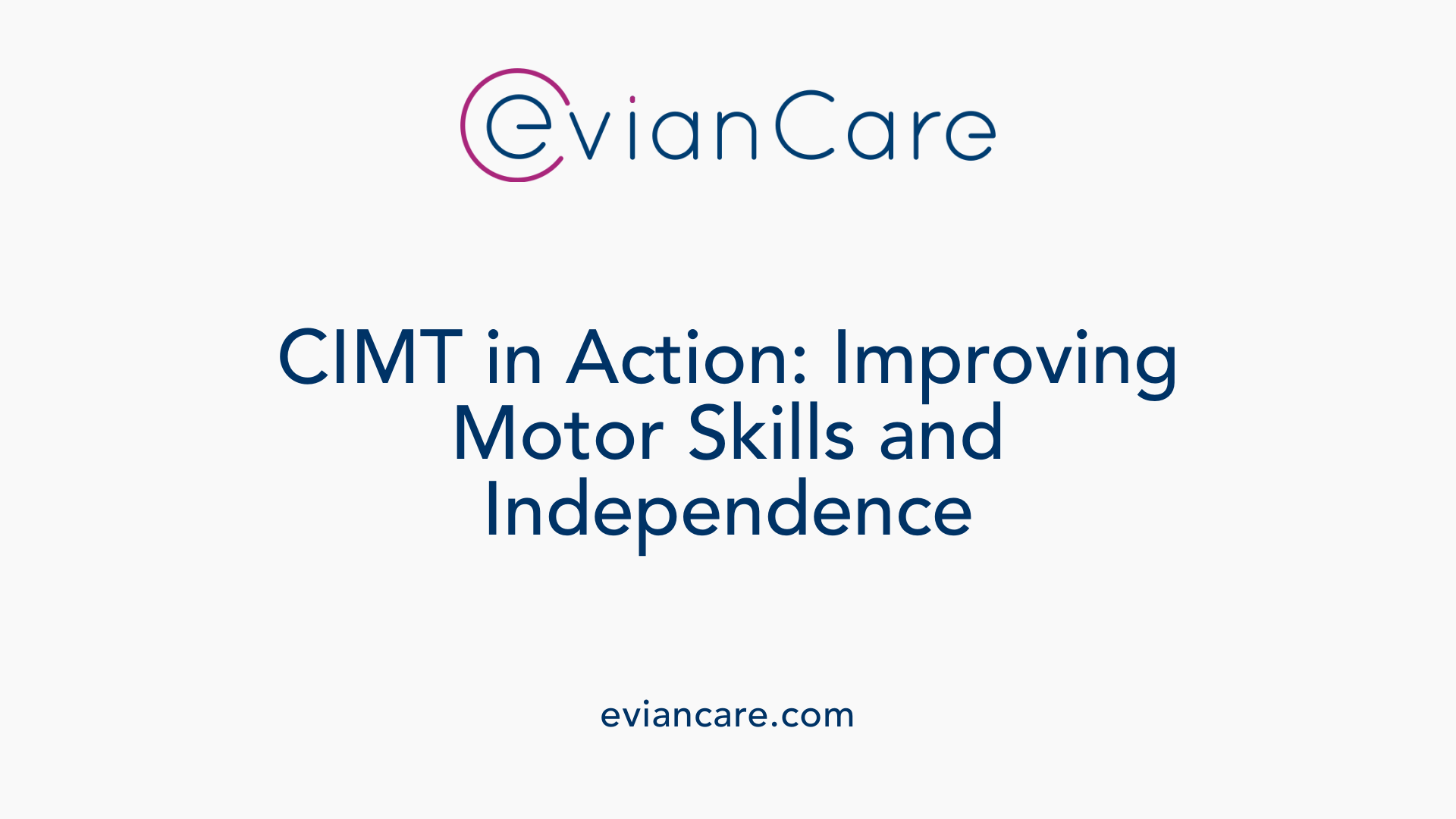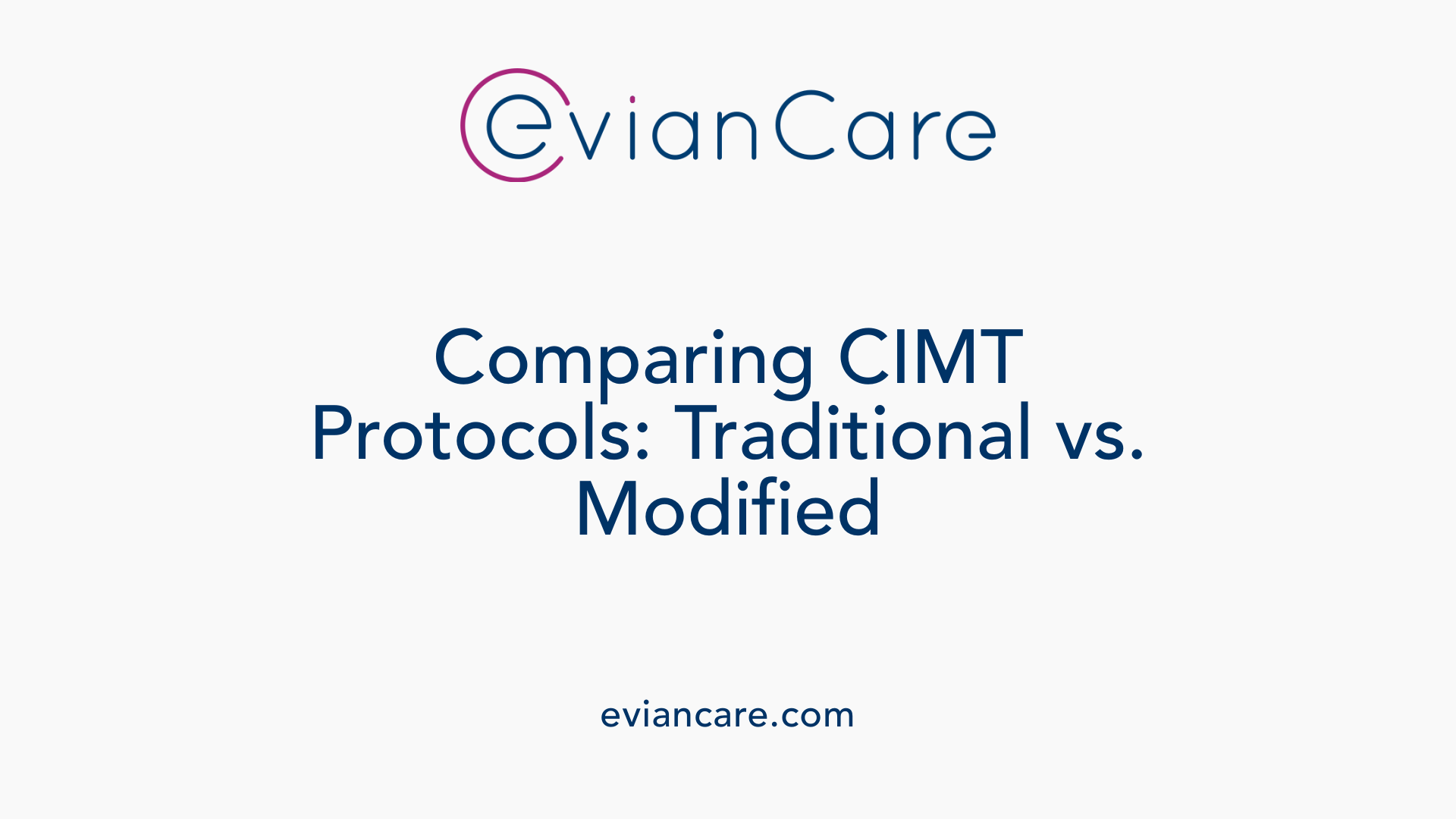
Understanding Constraint-Induced Movement Therapy (CIMT)
Constraint-Induced Movement Therapy (CIMT) is a cutting-edge neurorehabilitative intervention designed to significantly improve upper limb function in individuals recovering from stroke or neurological injuries. Its foundational principle revolves around behavioral and neuroplasticity-driven techniques that promote the use and functional recovery of the affected limb.
Fundamentals of CIMT: Principles and Mechanisms

What is Constraint-Induced Movement Therapy (CIMT) and how does it work?
Constraint-Induced Movement Therapy (CIMT) is a rehabilitation strategy used to improve the use of an affected limb, especially after stroke. It involves restraining the unaffected limb, typically by using a mitt or sling, for most of the day while engaging the affected limb in intensive practice. This approach aims to counteract learned non-use, a common phenomenon where patients favor their unaffected limb, leading to further deterioration of the affected limb’s function.
The therapy emphasizes repeated, task-specific training through principles of motor learning such as mass practice, shaping, and behavioral techniques like feedback and encouragement. Both traditional CIMT—where the unaffected limb is restrained for about 90% of waking hours over 2-3 weeks—and modified versions, which involve fewer hours of restraint and therapy, have demonstrated effectiveness.
Underlying mechanisms of CIMT revolve around fostering neural plasticity in the brain. This includes increased cortical activation, reorganization of motor areas, and synaptic growth, all of which support improved motor function and control. Neuroimaging studies have shown that CIMT leads to greater involvement of brain regions controlling the affected limb, promoting plastic changes that underpin functional recovery.
Methods involved in CIMT typically combine restraining the unaffected limb with intensive, functional task practice of the affected limb. This combination not only improves motor capacity but also encourages the transfer of skills to real-world activities, ultimately enhancing independence and activity participation.
Scientific Evidence Supporting CIMT Effectiveness
What is the scientific evidence supporting the effectiveness of CIMT for upper limb recovery after a stroke?
The effectiveness of Constraint-Induced Movement Therapy (CIMT) and its modified form (mCIMT) in stroke rehabilitation is strongly supported by a substantial body of high-quality research. Multiple systematic reviews and meta-analyses, involving thousands of participants, consistently show that CIMT significantly improves upper limb motor functions.
Research outcomes reveal that CIMT produces moderate to large improvements in motor capacity and activity levels. For instance, meta-analyses report effect sizes of approximately 0.51 to 0.55, indicating meaningful gains in arm and hand function shortly after therapy. These improvements are often maintained for months, with some studies noting benefits persisting up to a year or longer.
Neuroimaging studies have illustrated increased cortical activation and reorganization following CIMT. Such changes in brain activity are closely linked to functional recovery, providing a biological basis for observed improvements.
Clinical trials, including the well-known EXCITE trial, demonstrate that patients treated with CIMT show superior outcomes in arm motor function tests, daily activity performance, and overall independence compared to those receiving standard care. Both in-person and remotely delivered CIMT programs have shown comparable effectiveness, reflecting the therapy's flexibility and potential for broader application.
Most evidence indicates that patients with residual, voluntary motor control of the affected limb derive the greatest benefits. Conversely, CIMT appears less effective in the acute phase for pain, spasticity, or overall stroke outcomes, though it remains valuable for motor and functional recovery later in the process.
Overall, the accumulated research affirms CIMT as a scientifically validated approach that leverages brain plasticity principles to improve upper limb function, thereby enhancing quality of life for stroke survivors.
Outcomes and Benefits of CIMT in Rehabilitation

What are the benefits and outcomes associated with CIMT for upper limb rehabilitation?
Constraint-Induced Movement Therapy (CIMT) is a promising approach for rehabilitating upper limb function after stroke and neurological injuries. It primarily aims to improve motor control and increase the affected limb’s use in everyday activities. High-quality evidence from multiple randomized controlled trials consistently shows that CIMT can produce significant improvements in motor skills, especially in individuals who retain some voluntary hand and wrist movement.
Research has demonstrated that CIMT leads to measurable advances in motor assessments like the Fugl-Meyer Assessment, Wolf Motor Function Test, and the Motor Activity Log. These assessments reflect improvements in overall movement quality, speed, and the frequency of affected limb use. Consequently, patients often experience greater independence and participation in daily life tasks.
Beyond motor improvements, CIMT promotes positive changes in the brain, known as neuroplasticity. Neuroimaging studies reveal increased cortical activation and representation in brain areas governing the affected limb. This cortical reorganization is closely linked with functional gains, indicating that CIMT encourages the brain to adapt and rewire itself, supporting ongoing recovery.
Researchers also have found that combining CIMT with other techniques, such as trunk restraint or brain stimulation methods like transcranial direct current stimulation (tDCS), can further amplify benefits. These combined interventions may accelerate recovery and lead to longer-lasting improvements.
Effectiveness of CIMT is not limited to stroke survivors. It has shown encouraging results in children with cerebral palsy, where it improves upper extremity function significantly. Additionally, adapted or less intensive versions of CIMT, like modified CIMT (mCIMT), allow for flexible and accessible therapy options, including home-based programs.
Overall, CIMT substantially enhances motor performance and promotes brain changes that support functional recovery. Patients often report not only better movement but also increased confidence and social participation. As a versatile and evidence-based therapy, CIMT can be tailored to individual needs, making it an integral part of comprehensive neurorehabilitation programs.
| Aspect | Outcome | Evidence Source |
|---|---|---|
| Motor function | Significant improvements in motor assessments | Systematic reviews, RCTs |
| Functional use | Increased use of affected limb in daily activities | Clinical trials, meta-analysis |
| Brain reorganization | Cortical activation and re-mapping observed | Neuroimaging studies |
| Combination therapies | Enhanced results with adjunct interventions | Research on tDCS, trunk restraint |
| Application in children | Improved upper extremity function in cerebral palsy | Pediatric studies |
In summary, CIMT fosters better motor control, supports neural reorganization, and helps patients regain independence, demonstrating its vital role in modern neurorehabilitation.
Populations Benefiting from CIMT

Which populations benefit most from CIMT?
Constraint-Induced Movement Therapy (CIMT) has shown to be effective for various groups experiencing motor impairments due to neurological events. Among the primary populations that benefit most are stroke survivors who retain some degree of movement in their affected upper limb. These individuals typically demonstrate enough residual hand and wrist function to participate actively in therapy sessions.
CIMT has also been extensively studied and applied in children with cerebral palsy (CP). Research indicates that children with hemiparesis—weakness or paralysis on one side of the body—experience significant improvements in upper limb function after receiving CIMT. The therapy helps promote increased use of the affected hand during daily activities, fostering better motor control and independence.
Beyond stroke and cerebral palsy, CIMT is applicable to other neurological conditions. Patients with traumatic brain injury, multiple sclerosis, spinal cord injuries, phantom limb pain, or focal hand dystonia may also benefit, especially when they possess enough baseline motor capacity to participate in the training.
Successful application of CIMT across all these populations depends on several factors. Patients should generally have sufficient motor function, cognitive ability to understand and follow instructions, and motivation to adhere to the intensive therapy schedule. Programs are often tailored to meet individual needs, ensuring safety and maximizing benefit.
Overall, CIMT's versatility makes it suitable for adults and children alike, especially those with unilateral brain injuries affecting one upper limb. The therapy's focus on repetitive practice and behavioral techniques encourages functional use of the affected limb, leading to improved everyday activity performance, regardless of age or specific neurological diagnosis.
Modified CIMT Versus Traditional CIMT

How does CIMT compare to modified CIMT (m-CIMT)?
Constraint-Induced Movement Therapy (CIMT) is known for its intensive approach, involving the restrained use of the unaffected limb for about 90% of waking hours over two to three weeks. During this period, patients undergo about six hours of daily therapy focused on task-specific training of the affected limb. This intense protocol aims to promote cortical reorganization and enhance functional recovery after stroke.
In contrast, modified CIMT (m-CIMT) adopts a more flexible and less demanding approach. It typically involves shorter constraint durations per day, often around three hours, with therapy sessions extending over at least four weeks. mCIMT emphasizes home practice and varies in protocol specifics, which makes it easier for patients to adhere to and more feasible within different healthcare settings.
Both CIMT and mCIMT share core principles such as behavioral techniques and task-specific training to increase use of the affected limb. Importantly, research suggests that mCIMT can produce comparable improvements in motor function and daily activity levels, especially in individuals with chronic stroke.
The main differences between the two are related to their intensity and time commitment. While traditional CIMT involves high-dose, complete restraint, mCIMT offers a more adaptable approach suitable for those who may not tolerate the full protocol.
Overall, mCIMT provides an effective, more practical alternative to traditional CIMT, maintaining the therapeutic benefits of increased limb use while improving accessibility and patient adherence. Both protocols aim to increase neural plasticity and functional independence, with evidence supporting the use of either approach based on individual needs, capabilities, and resources.
Theoretical and Clinical Foundations of CIMT
What is the theoretical basis of CIMT and its clinical principles?
Constraint-Induced Movement Therapy (CIMT) is grounded in the concepts of neuroplasticity and learned non-use. Neuroplasticity refers to the brain's ability to reorganize itself by forming new neural connections, especially following injury like a stroke. When an individual consistently avoids using the affected limb, the brain tends to deactivate its motor pathways, leading to further decline in function—a phenomenon known as learned non-use.
CIMT addresses this by constraining the unaffected limb, typically with a sling or mitt, for most waking hours. This forces the patient to use the impaired limb in daily activities, which enhances neural engagement and promotes cortical reorganization. The therapy is characterized by intensive, task-specific practice—often involving several hours daily over several weeks—that employs behavioral techniques such as shaping and repetitive task training.
Research using neuroimaging methods has demonstrated tangible changes in the brain following CIMT. These include increased cortical activation and the expansion of neural representations associated with the affected limb. Such neurophysiological adaptations are believed to underpin the functional improvements observed.
Clinically, CIMT incorporates principles like massed practice and behavioral shaping to reinforce use-dependent neuroplasticity. The therapy stimulates synaptic growth and neural remodeling, supporting motor recovery and functional independence. Overall, CIMT exemplifies how targeted behavioral interventions, aligned with an understanding of neuroplastic mechanisms, can effectively enhance motor outcomes after neurological injury.
The Role of Neuroimaging in Understanding CIMT's Impact
 Neuroimaging studies have become a crucial tool in understanding how Constraint-Induced Movement Therapy (CIMT) influences brain function and structure after stroke or neurological injury.
Neuroimaging studies have become a crucial tool in understanding how Constraint-Induced Movement Therapy (CIMT) influences brain function and structure after stroke or neurological injury.
Research using advanced brain imaging techniques—such as functional magnetic resonance imaging (fMRI)—demonstrates that CIMT leads to increased cortical activation in regions associated with movement control of the affected limb. This heightened activity suggests that the brain is reorganizing itself to adapt and improve motor performance.
Furthermore, neuroimaging has shown that CIMT fosters neural restructuring, including expansion of cortical representations of the affected limb. These changes are closely correlated with clinical improvements in motor abilities, indicating that CIMT not only improves function but also induces measurable neuroplasticity.
These findings support the concept that intensive, targeted motor training can promote brain reorganization, which is crucial for recovery. The increased cortical involvement and reorganization show promising potential in maximizing the brain’s capacity to recover following injury.
Research consistently indicates that these neural modifications underpin the functional gains observed in patients undergoing CIMT. This evidence reinforces CIMT’s role as a therapy that leverages neuroplasticity to enhance motor recovery.
| Brain Imaging Studies | Findings | Implications |
|---|---|---|
| Functional MRI (fMRI) | Increased activation in motor areas | Tracks functional brain changes post-CIMT |
| Cortical Reorganization | Expansion of cortical representation | Correlates with physical improvements |
| Neural Connectivity | Enhanced neural pathways | Supports recovery and skill transfer |
Overall, neuroimaging provides vital insights into how CIMT facilitates brain adaptation, confirming its foundation in neuroplasticity-driven recovery.
Long-Term Efficacy and Future Directions
 What does research say about CIMT based on systematic reviews and meta-analyses?
What does research say about CIMT based on systematic reviews and meta-analyses?
Studies reviewing the effectiveness of Constraint-Induced Movement Therapy (CIMT) have consistently shown that it can lead to meaningful improvements in motor function for stroke survivors and children with cerebral palsy. Systematic reviews and meta-analyses analyzing multiple trials reveal that CIMT provides a moderate positive impact on upper limb motor capacity, with some reports indicating a standardized mean difference of around 0.58, which suggests a beneficial effect. However, the overall quality of evidence remains very low because of issues such as publication bias, inconsistency among studies, and limited follow-up periods.
In stroke rehabilitation, research highlights significant short-term benefits in upper limb function, with effects maintained for up to a year after therapy. The improvements are notable in performance measures like the Wolf Motor Function Test and Motor Activity Log, and include increased arm use in daily life. Though some benefits, such as those in balance and motor impairment, appear promising, the impact on broader functional mobility is less clear.
For children with cerebral palsy, ongoing research indicates that mCIMT (modified CIMT) can improve upper limb functionality, especially when splint constraints are used. Nonetheless, these findings are based on a limited number of trials with small sample sizes, and their evidence quality is rated very low, urging caution in interpretation.
Despite encouraging results, experts emphasize the importance of further high-quality, randomized controlled trials. Future research should focus on long-term outcomes, optimal therapy protocols, and identifying which patient groups benefit most. Expanding follow-up periods and standardizing treatment procedures will help clarify CIMT’s role in neurorehabilitation. Overall, while current evidence supports CIMT's effectiveness, more rigorous studies are necessary to establish definitive long-term benefits and refine clinical applications.
Clinical Application and Implementation Strategies

What is Constraint-Induced Movement Therapy (CIMT) and how does it work?
Constraint-Induced Movement Therapy (CIMT) is a rehabilitation approach specifically designed to improve upper limb function following stroke or neurological injuries. The core principle involves restraining the unaffected limb, usually with a mitt or sling, to encourage the use of the affected arm. This process aims to combat learned non-use, a common issue where patients favor their unaffected limb, leading to further disuse and functional decline.
In practice, CIMT includes intensive, task-specific practice sessions that focus on the paretic (weakened or affected) limb. Through repetitive training, patients perform activities that promote motor recovery by leveraging neuroplasticity—the brain's ability to reorganize itself. Techniques such as shaping—gradually increasing task difficulty—and behavioral strategies help transfer gains into everyday life.
Research shows that CIMT stimulates neuroplastic mechanisms including increased cortical activation, rebound of neural pathways, and synaptic growth. Neuroimaging studies further support these findings by showing enhanced brain reorganization post-therapy.
There are two main models of CIMT:
| Model Type | Restraint Duration | Daily Practice | Typical Duration | Key Feature |
|---|---|---|---|---|
| Unmodified CIMT | 90% of waking hours | Tasks for 6 hours | 2-3 weeks | Strict restraint, intensive therapy |
| Modified CIMT (mCIMT) | Fewer hours, often 3 hours daily | Focused task practice | Minimum 4 weeks | Less intense, more adaptable |
This therapy is beneficial for individuals who retain some hand movement, are motivated, and can participate actively. It has demonstrated significant improvement in motor function, arm use, and even long-term maintenance of these gains.
While side effects are minimal—mainly skin soreness or irritation—CIMT does not increase shoulder pain and is considered safe. Its effectiveness varies depending on stroke phase, severity, and protocol specifics, but overall evidence supports its role in improving functional outcomes.
Furthermore, adapted versions like group mCIMT or combining therapy with brain stimulation techniques (like tDCS) can enhance recovery. Early intervention, especially in children with cerebral palsy, leverages neuroplasticity during development, leading to improved arm use and independence.
Implementation strategies often include intensive protocols, home-based exercises, and caregiver involvement. Tailoring therapy to individual needs and circumstances ensures better engagement and outcomes, illustrating CIMT's versatility in neurological rehabilitation.
Future Perspectives and Integrative Approaches
As research advances, CIMT continues to evolve and integrate with novel neurotechnologies and personalized rehabilitation strategies. Ongoing investigations aim to optimize protocols, extend benefits to a broader range of neurological conditions, and ensure long-term sustainability of gains. The therapy’s neuroplasticity-driven foundation and its demonstrated clinical efficacy reinforce its vital role in upper limb neurorehabilitation, promising improved quality of life for stroke survivors and other affected populations.
References
- Constraint Induced Movement Therapy
- Constraint-induced movement therapy for upper ...
- Effectiveness of modified constraint-induced movement ...
- Constraint-Induced Movement Therapy
- Effect of Constraint-Induced Movement Therapy on Upper ...
- Effects of Constraint-Induced Movement Therapy on ...
- The effectiveness of modified constraint-induced movement ...
- Constraint-Induced Movement Therapy – Upper Extremity
- The Effect of Constraint-Induced Movement Therapy on ...












